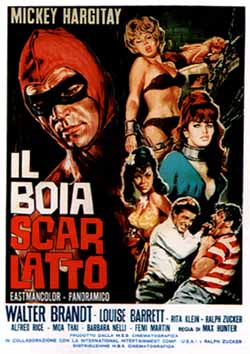|

Mickey Hargitay as the Crimson Executioner.
When a troop of photographers and models shows up at his castle, asking for permission to use the grounds while they stage photographs for book dust jackets, Anderson orders them to leave immediately: "I don't like having my privacy disturbed." But he relents when he recognizes one of the women--an old girlfriend of his--and agrees to let them stay for one night, on the condition that they "Don't go near the dungeons. They're absolutely out of bounds for everyone." Of course, the very next scene shows the models and photographers messing around with a medieval torture device.
Anderson's obsessive contemplation of his body and the erotic pleasure he derives from his own caresses doesn't bode well for the health of the visitors. After he spies on the women while they are changing into their skimpy outfits, he begins talking about "the contagion of human sentiment." He considers sexual desire to be a weakness and he blames those people who create desire within him as carriers of a contagion--and therefore they should be exterminated. He dons a black mask, a red skull cap, a golden medallion, and red leotards. He assumes the identify of the castle's medieval owner: "I know of only one who was never overcome by weakness--the Crimson Executioner. He despised your world as passionately as I do. . . . His magnificent body was preserved intact through all these centuries undisturbed. His spirit lives in me. And I'll continue his mission of vengeance. This is the sacred duty I've sworn to. . . . His noble crusade against sin lives again through me!"
Anderson captures the women and men and he takes them to the castle's dungeon, where he tortures them with a variety of devices. One device is a wooden pylon upon which he ties two women. Razor sharp blades nick their nearly naked bodies as the pylon rotates. Anderson shakes in spasms of pleasure as the blades slice away clothing and draw blood. He feverishly pounds the blades deeper and deeper as the women writhe in agony. Bloody Pit of Horror gives us both men and women as victims, but the filmmakers take greatest pleasure when women are victims. Men tend to be killed quickly (with the exception of the publisher, who is slowly burned alive), while women are killed only after they have endured extreme agony.

The Crimson Executioner loves his work in Bloody Pit of Horror.
Interestingly, the choice of victims tends to align the filmmakers with Anderson. The movie kills off those characters who are overtly sexual (or greedy). All the scantily-clad women models die grisly deaths. Only one woman survives, and she survives mainly because she keeps her clothes on (until Anderson rips them off, that is). And of the men who die, we find the publisher (who pushes the women to continue modeling even after the first deaths have occurred) and two make-out artists who are forever pushing the women for sexual favors. The only male survivor expresses disgust at the publisher and the models:
"I know exactly how you feel, girls," says the publisher. "But we must finish our work before daybreak."
"With poor Perry laying dead?" says a model.
"I'll double your salary."
"My life's worth more than that."
"Triple it."
"OK. It's a deal."
"Me, too," chirps another model.
"I thought I'd seen just about everything," says the writer. "But this kind of bargaining is really more than I can stand."
Because the film suggests the moral superiority of the writer, he gets to survive. But he doesn't just survive, he actually becomes the hero. He single-handedly takes on Anderson and his crew of henchmen. Unfortunately, the writer (played by Walter Brandi, a veteran of Italian horror movies, such as The Vampire and the Ballerina and The Playgirls and the Vampire) is flabby and hardly credible as competition for the muscle-bound Anderson. His ascot and cardigan sweater even manage to make him look softer yet. However, when he shows up in the dungeon to challenge Anderson and put an end to the tortures, Anderson reacts in disbelief and backs away, screaming for his henchmen to come to his aid. Brandi stands awkwardly, never quite sure what to do. When called to take action, however, he delivers vicious karate chops that knock out the henchmen. In one of the most ridiculous scenes in the movie, he slinks like an inch worm across the floor of a room--while trying to avoid the strands of a giant spider web and save a woman who is menaced by one of the silliest looking giant spiders ever created. The shear silliness of the premise and the unforgiving awkwardness of Brandi's situation make the scene absolutely surreal.
But the real focus of Bloody Pit of Horror is Mickey Hargitay's naked, oily torso. The movie gives us Hargitay's muscular form to contemplate, under the belief that we will derive pleasure from looking at his naked chest and his skin-tight leotards (and his bulging crotch, which director Pupillo insists was stuffed with cotton by Hargitay). Least the men in the audience become uncomfortable with the arguably homo-erotic contemplation of the male body beautiful, the filmmakers redirect the desire toward scantily clad, sexually available young women, who dress as pirates and Polynesian beauties, and not surprisingly, violence is the result--as Anderson must punish the women for their sexuality.
Bloody Pit of Horror can also be read as a comment on Italy's love of Hercules and other muscle-bound heroes. Bloody Pit of Horror suggests that obsession with physical perfection can be mentally destructive. Whereas the muscular heroes of Hercules and its multitude of sequels are always projected as near perfect heroes, Bloody Pit of Horror suggests that the quest for physical perfection--when coupled with a superior attitude--can leave people crippled psychologically and unable to function in society.
It's hard to believe that Bloody Pit of Horror was directed by the same man who made Terror Creatures from the Grave (Italian title: Cinque Tombe Per Un Medium). The movies are nothing alike. While Bloody Pit of Horror is blunt and harsh, Terror Creatures is atmospheric and stylish. Writers have argued about who directed these two movies. How could it have been the same man? Adding to the confusion, director Massimo Pupillo did not receive directorial credit on either picture. Producer Ralph Zucker (who only directed a few scenes shot exclusively for the American release) received credit for Terror Creatures, while Bloody Pit of Horror was credited to Pupillo's pseudonym, Max Hunter. Certainly if the same man did do both movies, then he must have been one of the least influential men on the movie set.
Pupillo himself put this issue to rest with an interview published in Bizarre Sinema! Horror all'italiana (Italy: Glittering Images, 1996) where he announced that he had indeed directed both movies. Maybe the problem of authorship can be attributed to the other talent behind the camera. Carlo Di Palma, for example, is credited as the cinematographer of Terror Creatures, and he would go on to lense several movies for Woody Allen (including Hannah and Her Sisters, Bullets Over Broadway, and Everyone Says I Love You). Also, Terror Creatures was written by Romano Migliorini and Roberto Natale, who would go on to write Mario Bava's gothic horror masterpiece Kill, Baby, Kill.
Bloody Pit of Horror may not be a particularly profound work of cinema, but its situations are so outlandish that you'll frequently find your jaw hanging open. This is '60s Italian gothic horror at its kinkiest.
Italian Horror Menu page
Italian Horror: A Brief Introduction
Mario Bava: The Illusion of Reality
Mario Bava's Rabid Dogs
Mario Bava Biography
The Horrible Dr. Hichcock
The Devil's Commandment 
Castle of Blood 
Nightmare Castle
The Bloody Pit of Horror 
Italian Horror in the Seventies
Suspiria
Italian Horror Web Links
Photo credits: Sinister Cinema.
|





